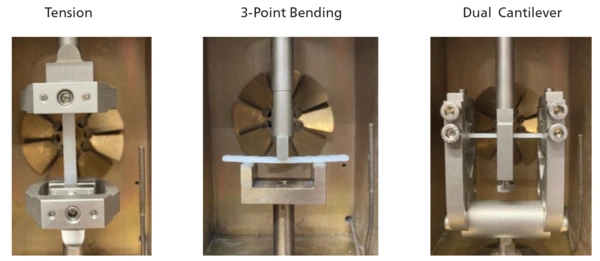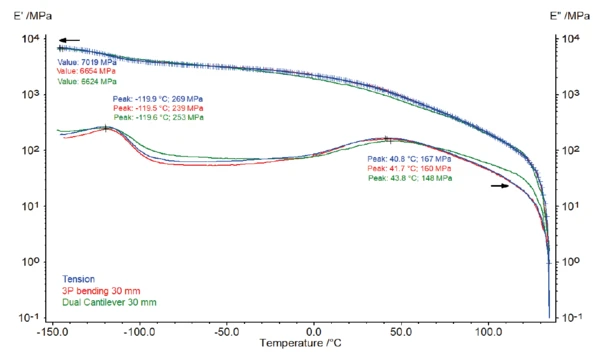Introduction
Different load types are used in DMA. The sample is loaded in tension, compression, bending or shear. Often, the load applied is determined by the future application, but sometimes, the load type can be freely selected. In any case, the question arises as to what extent the results are comparable. In this application note, the loading modes that are particularly relevant to polymer applications – tension, free bending (3-point bending) and clamped bending (dual cantilever) – are compared.
Comparative Measurement of PE-HD
As an example, a semi-crystalline thermoplastic, PE-HD, was investigated in a DMA GABO Eplexor® 500 N (figure 1). It was a homogeneous sheet material divided into dimensionally precise samples with dimensions of 55 x 5 x 2 mm by means of a milling machine.
In order to achieve a maximum measuring effect, the tensile sample is clamped to a length of 35 mm. In 3-point bending, a support width of 30 mm is selected, as this is a good compromise between various factors. With even smaller support widths, undesirable contact effects at the bearing points play a greater role: With larger bearing widths, the sample bends too much in the softening range, whereby tensile stresses are increasingly superimposed and the measurement no longer yields meaningful results.
With identical material and dimensions, the sample is much stiffer in tension than in bending. Accordingly, more than 50 N are required in tension to achieve the dynamic strain of 0.1%. In bending, a somewhat larger target strain of 0.15% was set in order to increase the measurement effects in the softening range and also to achieve sufficient compression in the supports of the free bending. In clamped bending (dual cantilever), however, 9 N is sufficient for achieving the target strain, and in free bending, even 5 N is enough. Thus, the dynamic strains are always in the linear elastic range (ISO 6721 stipulates a typical maximum strain of 0.2%). For the static load, a proportional control (FStat = PF * FDyn) is used in all cases. Measurements are carried out in the temperature range from -150°C to +150°C at a heating rate of 2 K/min. The measurement parameters are summarized in table 1.

As can be seen in figure 2, the Young’s modulus versus temperature is largely identical for the different load modes; for a homogeneous material, therefore, it is not necessary to distinguish between a bending and a tension module. Storage modulus E* is initially measured somewhat lower in tension at -150°C than in bending, but thereafter, the storage moduli in tension and free bending are largely identical. In the softening range, the sample will be strongly deformed in the bending sample holders. That’s why it is possible here to measure somewhat lower moduli in tension mode.
In clamped bending (dual cantilever), the measured storage modulus is somewhat lower beginning at approx. -50°C. This behavior is also reflected in Viscous modulusThe complex modulus (viscous component), loss modulus, or G’’, is the “imaginary” part of the samples the overall complex modulus. This viscous component indicates the liquid like, or out of phase, response of the sample being measurement. loss modulus E”: While the values in tension and bending are very similar, those measured in clamped bending deviate a little (green curve). The reason for this is considered to be that a complex ContrainteLa Contrainte est définie par un niveau de force appliquée sur un échantillon d’une section bien définie. (Contrainte = force/surface). Les échantillons qui possèdent une section rectangulaire ou circulaire peuvent être comprimés ou étirés. Les matériaux élastiques comme les élastomères peuvent être étirés jusqu’à 5 à 10 fois leur longueur initiale.stress state already occurs in the sample during the clamping and, in contrast with the situation in tension, it then becomes no longer possible to compensate for additional linear expansion of the sample. Especially during a temperature sweep, additional thermal stresses are also generated which even further ContrainteLa Contrainte est définie par un niveau de force appliquée sur un échantillon d’une section bien définie. (Contrainte = force/surface). Les échantillons qui possèdent une section rectangulaire ou circulaire peuvent être comprimés ou étirés. Les matériaux élastiques comme les élastomères peuvent être étirés jusqu’à 5 à 10 fois leur longueur initiale.stress the sample.

Table 1: Measurement parameters used and required force
| Tension | Three-Point Bending | Dual Cantilever (30 mm) | |
| Dynamic strain | 0.1% at 1 Hz | 0.15% at 1 Hz | |
| Static load | 1.1 PF | 1.5 PF | FStat = 0 N |
| Heating rate | 2 K/min | 2 K/min | 2 K/min |
| Resulting measuring force | >50 N | 5 N | 9 N |
General Information on the Use of Load Modes
When a sample is bent, the stress that is applied varies across the cross-section. In the case shown in figure 3, a compressive stress acts on the upper side of the sample, and a tensile stress on the lower side. In addition, the bending moment and also the stress vary along the sample’s length. This means that specified strains or stresses in bending always apply only in the outer fibers and lengthwise in the center of the sample.

If the material behavior is dependent on strain, it basically makes little sense to measure in bending. Therefore, in ISO 6721, a measurement mode with uniform stress state – i.e., tension, compression or shear – is also generally recommended for non-linear polymers. With regard to the sample’s dimensions, ISO 6721 imposes some restrictions which are summarized in table 2.
Table 2: Permissible sample geometries in accordance with ISO 6721
| Tension | Length / width > 6 |
| 3-Point-Bending | Bearing width / Sample height > 16 Bearing width / Sample height > 6 |
| Dual Cantilever | Free bending length / Sample height > 32 Free bending length / Sample height > 12 |
This is to ensure that clamping or storage only exerts relatively little influence on the results. In practice, relatively strong deviations often show, especially in clamped bending for stiffer samples. Therefore, it is recommended to test only relatively thin or soft samples with the dual cantilever sample holder.
Conclusion
Plastics are mainly measured in tension, free or clamped bending. Using the example of a homogeneous PE-HD sample, it was possible to show that almost identical results are obtained in tension and free bending under ideal conditions, while slight deviations occur in clamped bending (dual cantilever).
If a material is at all dependent on the amplitude, the sample should be measured in tension. The DMA GABO Eplexor® 500 N offers all possibilities to this end.